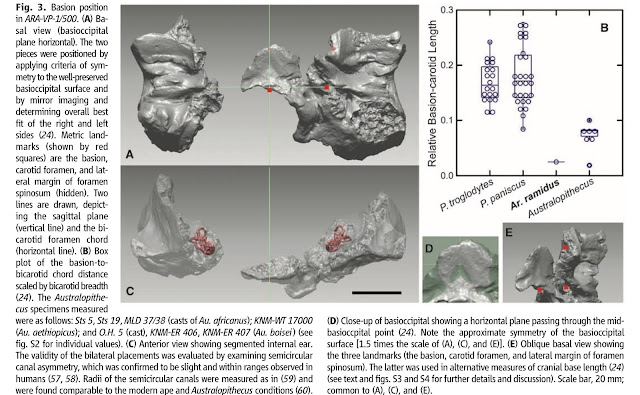Ardipithecus ramidus is one of our earliest relatives and one of our best indicators for how humans and chimps diverged from our common ancestor. After the discovery of Ar. ramidus at Aramis Ethiopia in 1994 it took until 2009 for scientists to publish the findings. The skeleton of Ar. ramidus has both ape-like and human-like features and gives us a picture of how us hominids got some of our human traits. In the article ‘The Ardipithecus ramidus Skull and its Implications for Hominid Origins’(https://science-sciencemag-org.proxy006.nclive.org/content/326/5949/68/tab-pdf) the traits of the skull are focused on in order to highlight the evolutionary process. The features of the skull in general can be divided into three sections: the basicranial structure, the face and vault, and the cranium. These parts can show the unique features of Ar. ramidus.
Basicranial Structure
The basicranial structure is one of the more important cranial features to consider when looking at the evolution of our species. This is where we examine one of my favorite skull features: the foramen magnum. The article discusses this feature in a rather defensive manner as the original statements regarding the foramen magnum were contested. They note the anterior position of the foramen magnum that suggests bipedalism in Ar. ramidus is within the hominin range of the basi-ovale distance.
Face and Vault
The face of Ar. ramidus shows us another phase in the evolution of hominins. Compared to chimps the species has a very short face with a small prognathism. The article also focuses in on the fossilized teeth. Both the molars and other teeth give indications of more derived traits. The article brings attention to the large molars for chewing harsher foods as this trait is also seen in robust Australopithecus. The facial bones also show less sexual dimorphism in this species as opposed to apes.
Cranium
The most important feature of the Ar. ramidus cranium is it’s capacity. The estimated brain size of the species is 300-35cc. The implications of brain size has been highly contested within the scientific community but in the earliest hominins it is particularly interesting to see where we began to increase in brain size. For a hominin Ar. ramidus has an incredibly small brain, but shows evidence of cranial base flexion. This could be an evolutionary link with our bonobo relatives or a derived trait that Australopithecus would later share.



Amazing job here, Gabby! I'm always amazed about how they had to put all the pieces of this crushed skull together and how much time that must have taken. The apparent lack of sexual dimorphism is really interesting and fits with what Lovejoy was saying about a change in mating patterns being part of the push towards bipedalism. this is a tough paper but you cover it well and nice use of images
ReplyDeleteI also like that you have a favorite skull feature! mine is the occiptal condyle :)